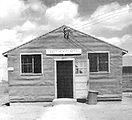
Mather Air Force Base was a United States Air Force Base, which was closed in 1993 pursuant to a post-Cold War BRAC decision. It was located 12 miles (19 km) east of Sacramento, on the south side of U.S. Route 50 in Sacramento County, California. Mather Field was one of 32 Air Service training camps established after the United States entry into World War I in April 1917.

Foster Air Force Base is a former United States Air Force facility in Texas, located in Victoria County, approximately six miles (10 km) east-northeast of Victoria.

Santa Ana Army Air Base (SAAAB) was a World War II-era air base located near Santa Ana, California. The air base was decommissioned in 1946, and part of the land was annexed by Costa Mesa in 1953. The air base was used for basic training, although it did not have planes, hangars or runways. The base was 1,336 acres (5.41 km2), and the main section of the base was located between Baker Street to the north, Harbor Boulevard to the west, Wilson Street on the south, and Newport Boulevard on the east. The land formerly occupied by the air base is today the home of John Wayne Airport, the Orange County Fairgrounds, and Orange Coast College.

Sharpe Field is a closed private use airport located six nautical miles northwest of the central business district of Tuskegee, a city in Macon County, Alabama, United States. This airport is privately owned by the Bradbury Family Partnership.

Ellington Field Joint Reserve Base is a joint installation shared by various active component and reserve component military units, as well as aircraft flight operations of the National Aeronautics and Space Administration (NASA) under the aegis of the nearby Johnson Space Center. The host wing for the installation is the Texas Air National Guard's 147th Attack Wing. Opened in 1917, Ellington Field was one of thirty-two Air Service training camps established after the United States entry into World War I. It is named for First Lieutenant Eric Ellington, a U.S. Army aviator who was killed in a plane crash in San Diego, California in 1913.

Bombardier is a 1943 film war drama about the training program for bombardiers of the United States Army Air Forces. The film stars Pat O'Brien and Randolph Scott. Bombardier was nominated for an Oscar in 1944 for the special effects used in the film. It was largely filmed at Kirtland Army Air Field, New Mexico, site of the first bombardier training school.

Hobbs Army Airfield was an airfield used during World War II by the United States Army Air Forces Air Training Command as part of the Western Flight Training Center. It is located in the vicinity of Hobbs, New Mexico.

Dalhart Army Air Base is a former World War II military airfield complex near the city of Dalhart, Texas. It operated three training sites for the United States Army Air Forces from 1943 until 1945.

The United States Army Air Forces during World War II had major subordinate Commands below the Air Staff level. These Commands were organized along functional missions. One such Command was the Flying Training Command (FTC). It began as Air Corps Flying Training Command on 23 January 1942, was redesignated Army Air Forces Flying Training Command (AAFTC) on 15 March 1942, and merged with Army Air Forces Technical Training Command to become Army Air Forces Training Command on 31 July 1943. Continuing service after the war, it was redesignated Air Training Command on 1 July 1946. During the consolidation of Air Force Major Commands in the retrenchment of the 1990s, Air Training Command assumed control of Air University and became Air Education and Training Command on 1 July 1993—today's Air Education and Training Command (AETC), which celebrated its 75th anniversary 23 January 2017. see the Lineage and honors statement for AETC.

Coffeyville Army Airfield was a World War II training base of the United States Army Air Forces Central Flying Training Command (CFTC). It was later used by Third Air Force. Today, it is the city-owned Coffeyville Municipal Airport, Kansas.

Midland Army Airfield is a former World War II military airfield, located 8.4 miles west-southwest of Midland, Texas. It operated as a Bombardier training school for the United States Army Air Forces from 1942 until 1945.

San Angelo Army Airfield is an inactive United States Air Force base, about 8 miles south-southwest of San Angelo, Texas. It was active during World War II as a training airfield. It was closed on 30 November 1945.

Flying Division, Air Training Command, was a training formation of the United States Air Force. The unit was established in 1926 as the Air Corps Training Center to be the primary pilot training center for the Air Corps. It was reorganized into one of three training commands created by the Office of the Chief of the Air Corps in 1940 to accommodate the large number of air cadets being recruited as a result of the expansion of the corps after the fall of France. During World War II, thousands of cadets attended various flight schools throughout the Central United States being trained as pilots for fighters, bombers and transports. It also trained the navigators, bombardiers and gunners necessary for the bombers to attack enemy targets in the combat areas overseas. After World War II, it became the primary pilot and aircrew training unit of the United States Air Force Air Training Command.

Eagle Pass Army Airfield is a former World War II military airfield complex. It is located 10.6 miles (17.1 km) north of Eagle Pass, Texas. It operated as a training base for the United States Army Air Forces from 1943 until 1945.

A Bombardier School was a United States Army Air Forces facility that used bombing ranges for training aircrew. After ground simulator training with the Norden bombsight, the 12- to 18-week course recorded each student's scores for approximately 160 practice bomb drops of "Bomb Dummy Units" (BDU), both in daytime and at night. The elimination rate was 12%, and graduates transferred to a Second or Third Air Force training unit to join a crew being trained for overseas duty. The bombardier trainer used was the Beech AT-11 Kansan. With the Bradley Plan increase in Eighth Air Force aircrews needed for the Combined Bomber Offensive, the 17 Army Air Forces Bombardier Schools graduated 47,236.

The 78th Flying Training Wing was a wing of the United States Army Air Forces. It was last assigned to the Central Flying Training Command, and was disbanded on 30 June 1945 at the San Antonio Aviation Cadet Center, Texas.

The 81st Flying Training Wing is an inactive United States Air Force unit. It was last assigned to the Western Flying Training Command, and was disbanded on 1 November 1945 at the Santa Ana Army Air Base, California.

The 77th Flying Training Wing was a wing of the United States Army Air Forces. It was assigned to the Central Flying Training Command, and was based in Texas between 1943 and its disbandment on 16 June 1946.

The 34th Operations Group is an inactive United States Air Force unit. It was first activated as the 34th Flying Training Wing and supervised training of bombardiers and pilots for multiengine aircraftuntil it was disbanded on 16 June 1946 at Midland Army Air Field, Texas. The wing was reactivated in 1978 as the 34th Tactical Airlift Training Group and conducted various courses for crews of the Lockheed C-130 Hercules until inactivating in December 1961. It was activated a third time in 1994 as the 34th Operations Group and conducted airmanship training at the United States Air Force Academy.

Webb Air Force Base, previously named Big Spring Air Force Base, was a United States Air Force facility of the Air Training Command that operated from 1951 to 1977 in West Texas within the current city limits of Big Spring. Webb AFB was a major undergraduate pilot training (UPT) facility for the Air Force, and by 1969, almost 9,000 pilots had been trained at Webb. The last operational wing at Webb AFB was the 78th Flying Training Wing.








































